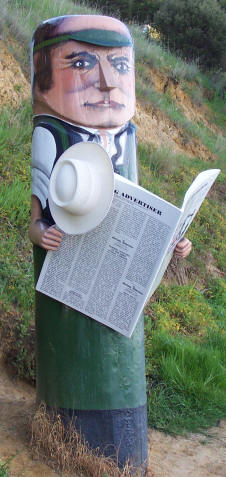(Related pages - Australian Inventions and innovations)
 Australia
has excelled in certain areas of endeavour as diverse as medicine, the
sciences, sport and inventions. It has done so to a degree well above what
would be expected from its small population.
Australia
has excelled in certain areas of endeavour as diverse as medicine, the
sciences, sport and inventions. It has done so to a degree well above what
would be expected from its small population.
When it comes to inventions, Australia is particularly good at creating them and notoriously bad at developing them, with a result that many Australian inventions end up being developed in other countries. A good example of this can be found in the ABC television program The New Inventors (and its predecessor The Inventors). Despite large numbers of (often fine) inventions being showcased and given national publicity, surprisingly few of these inventions have ever successfully made it to the stage of sustainable commercial production.
It is ironic that three of the main areas which have made us good at creating inventions � isolation, our education system and the Australian culture � have also been major contributors to us being poor at developing them. It is worth looking at the contribution of these three factors:
Isolation
Australia is a large landmass with a relatively small population and far removed from other predominantly Western populations. During the nineteenth century, it was a slow and expensive exercise to bring goods from England. This gave Australia a form of natural protection against imported items. By the late nineteenth century this natural protection was starting to lessen with faster and cheaper shipping and the first wave of globalisation. However, the newly formed nation of Australia quickly put up trade barriers to 'protect' local industries. The First and Second World Wars also created a form of protection. Shipment of goods from Europe was scarce and dangerous, and this threw Australia back on its own resources. All of this isolation and protection meant that if there was a problem or opportunity in Australia, there was a strong incentive and reward for a solution to be produced locally. This is fertile ground for inventiveness � necessity truly is the mother of invention.
Protection
|
However, just as these factors strongly favour local inventiveness, they also often work against commercial development of the product. The small local market often means that the economies of mass production are not possible unless overseas markets are tapped. In turn, the very factors which made it difficult to import products made it equally difficult to export them. The time and cost factors in transporting products over large distances may make them uncompetitively priced. Similarly, where Australia had 'protected' itself with trade barriers against other countries� products, those same countries could be expected to place trade barriers against Australian goods. Thus isolation and protection for a country of relatively small population both fosters invention and innovation and works against the development and bringing to market of these inventions.
In an isolated market, inventors are less likely to think about patenting their invention. They have a captive market, nobody else has a competitive product, and the rest of the world seems a long way away. Many Australian inventions were later patented by others overseas and developed there.
In recent decades, the effects of isolation and protection have dwindled. The relative cost and time of shipping physical goods has dramatically reduced. Also, the nature of products has changed. Many have become miniaturised making them quick and cheap to transport. Many more products, such as software, are now ideas-based and can be transported almost instantly around the world at virtually no cost. The relative demand for bulky items that you can drop on your foot has decreased dramatically.
Education
Australia�s education system encourages independent thinking and is very good at producing inventive and creative minds. It contrasts favourably with systems in some other countries which are based more on rote learning and lock-step training.
|
However, although the education system is conducive to creativity and innovation, it is often not well suited to learning how to develop and market a product. It is possible (as in my case) to travel through the whole education system from primary to postgraduate and never have a teacher or lecturer that has spent any significant time in the private sector or understood the workings of business. In Australia, history is usually made by those who take risks, but history is often written and taught by the risk-averse who have never ventured outside the safety of the taxpayer-funded sector. Thus there are many teachers and lecturers who have a strong negative attitude to business and enterprise woven through their courses, lectures and text books and where 'profit' or success in business are painted as somehow tainted.
This stance is often reinforced by institutions such as our national broadcaster. This is hardly a promising training ground for a young inventor to learn how to make their invention sustainable and marketable. They may well notice that many of their lecturers have invested significant wealth into property but probably own no shares in innovative start up companies. In fact the 2003 Global Entrepreneurship Monitor showed that Australia ranks badly compared with other countries in attitudes towards entrepreneurs and that Australians were less likely to see starting a business as a desirable career choice. Thus many inventors are forced to to self-educate themselves about developing, marketing and similar issues after they have finished their 'formal education'.
In recent decades some excellent schemes have been developed outside the education system to help plug this gap such as the YAA Business Skills Program (see below).
The Australian Culture
Australians are practical outdoor people, and the Australian culture (or hegemony) encourages people to 'have a go' and improvisation is encouraged. Australians have probably found more uses for the wire coat hanger than any people in the world. This naturally leads to more inventiveness than countries with rigid cultures.
|
However when inventors are ready to develop their product, the Australian culture presents them with a dilemma - it is neither acceptable to fail badly nor to succeed well. Unlike countries like the USA, Australia attaches a real stigma to trying and failing in business, thus the often necessary second and third attempts never occur. Australia has some of the harshest bankruptcy laws in the world which certainly discourages failing the first time round.
Similarly, the Australian culture tends to denigrate people who become world class or successful in their area. This is sometimes called The Tall Poppy Syndrome - the tall poppies get their heads cut off. The only areas where it is acceptable to succeed are sport or pop culture (such as pop music, TV or movies). As Robert Hughes put it - "Sport is the only form of elitism that Australia will accept - and that is its great hypocrisy".
For much of its history Australia has paid comparatively well for (often unsustainable) dumb jobs and comparatively poorly for smart jobs with a resulting 'brain drain' to countries which value intelligence more highly. This has also resulted in Australia rating very poorly on a world scale in terms of R&D (research and development). Robin Boyd in his important book The Australian Ugliness demonstrated how this culture had by the 1960s led to a manufacturing industry based on copying rather than innovating. Inventions often replace dumb jobs with smart jobs and are therefore resented and blocked by those not prepared to continue learning. Inventions often replace brawn with brain and replace those unwilling to change with those who are. Thus, like the Luddites in 19th century England, the Australian culture has often led to organisations and individuals blocking the development of inventions that would benefit others because they may have to retrain. This contrasts strongly with some other regions such as Scandinavia.
A culture that steers people to a risk-averse middle path, and a climate where political parties of most flavours can usually win more votes by temporarily propping up dumb short term jobs bought from multinational companies rather than promoting innovative Australian enterprises is not a good place to get your invention developed. As a result, venture capital is practically non-existent in Australia as most Australians choose to place their money in property and similar forms of unearned wealth creation rather than investing in ideas that generate earned wealth and jobs.
Some exceptions
Occasionally Australia is able to reverse the trend and develop and invention or discovery from overseas within Australia. One example is the high oleic peanut. This natural mutant of the peanut species which contains a proportion of ''healthier oils' than even olive oil was discovered in America. However, with natural breeding techniques and a flexible growing industry, Australia has been able to lead the world in bringing the high oleic peanut to market in commercial
BL |
Copyright © 1995 - 2026 White Hat. |

